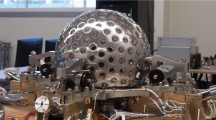Abstract
In this paper, we preliminarily explore the possibility of designing a dedicated satellite-based mission to measure the general relativistic gravitomagnetic Lense–Thirring effect in the gravitational field of Mars. The focus is on the systematic uncertainty induced by the multipolar expansion of the areopotential and on possible strategies to reduce it. It turns out that the major sources of bias are the Mars’equatorial radius R and the even zonal harmonics J ℓ, ℓ = 2, 4, 6, . . . of the areopotential. An optimal solution, in principle, consists of using two probes at high-altitudes (a ≈ 9,500–9,600 km) and different inclinations (one probe should fly in a nearly polar orbit), and suitably combining their nodes in order to entirely cancel out the bias due to δ R. The remaining uncancelled mismodelled terms due to δ J ℓ, ℓ = 2, 4, 6, . . . would induce a bias ≲ 1%, according to the present-day MGS95J gravity model, over a wide range of admissible values of the inclinations. The Lense–Thirring out-of-plane shifts of the two probes would amount to about 10 cm year−1.
Similar content being viewed by others
References
Lense J., Thirring H.: Über den Einfluss der Eigenrotation der Zentralkörper auf die Bewegung der Planeten und Monde nach der Einsteinschen Gravitationstheorie. Phys. Z. 19, 156–163 (1918)
Iorio L.: Comments, replies and notes: a note on the evidence of the gravitomagnetic field of Mars. Class. Quantum Gravit. 23, 5451–5454 (2006)
Iorio L.: Is it possible to measure the Lense–Thirring effect in the gravitational fields of the Sun and of Mars?. In: Iorio, L. (eds) The Measurement of Gravitomagnetism: a Challenging Enterptise, pp. 177–187. NOVA, Hauppauge (2007)
Krogh K.: Comments, replies and notes: comment on Evidence of the gravitomagnetic field of Mars. Class. Quantum Gravit. 24, 5709–5715 (2007)
Iorio, L.: Comment on evidence of the gravitomagnetic field of Mars, by Kris Krogh. J. Gravit. Phys. arXiv:gr-qc/0701146v4 (2008, in press)
Everitt, C.W.F.: The gyroscope experiment I. General description and analysis of gyroscope performance. In: Bertotti, B. (ed.) Proc. Int. School Phys. Enrico Fermi Course LVI, pp. 331–360. New Academic Press, New York (1974)
Everitt C.W.F. et al.: Gravity probe B: countdown to launch. In: Lämmerzahl, C., Everitt, C.W.F., Hehl, F.W. (eds) Gyros, Clocks, Interferometers. . .: testing Relativistic Gravity in Space, pp. 52–82. Springer, Berlin (2001)
Schiff L.: Possible new experimental test of general relativity theory. Phys. Rev. Lett. 4, 215–217 (1960)
Iorio, L.: An assessment of the measurement of the Lense Thirring effect in the Earth gravity field, in reply to: on the measurement of the Lense Thirring effect using the nodes of the LAGEOS satellites, in reply to On the reliability of the so far performed tests for measuring the Lense Thirring effect with the LAGEOS satellites by L. Iorio, by I. Ciufolini and E. Pavlis. Planet. Space Sci. 55, 503–511 (2007)
Iorio, L.: Advances in the measurement of the Lense–Thirring effect with Satellite Laser Ranging in the gravitational field of the Earth. In: Koslovskiy, V.V. (ed.) Progress in Laser and Electro-Optics Research. NOVA, Hauppauge. arXiv:0808.0658v1 [gr-qc] (2008)
Konolpiv A.S. et al.: A global solution for the Mars static and seasonal gravity, Mars orientation, Phobos and Deimos masses, and Mars ephemeris. Icarus 182, 23–50 (2006)
Kaula W.M.: Theory of Satellite Geodesy. Blaisdell, Waltham (1966)
Iorio L.: Appendix B the classical orbital precessions. In: Iorio, L. (eds) The Measurement of Gravitomagnetism: a Challenging Enterptise, pp. 239–245. NOVA, Hauppauge (2007)
Yoder, C.F.: Astrometric and geodetic properties of Earth and the solar system. In: Ahrens, T.J. (ed.) Global Earth physics a handbook of physical constants, Table 6. AGU reference shelf Series, vol. 1 (1995)
Yuan D.N. et al.: Gravity field of Mars: a 75th degree and order model. J. Geophys. Res. 106, 23377–23402 (2001)
Ciufolini I.: On a new method to measure the gravitomagnetic field using two orbiting satellites. N. Cim. A 109, 1709–1720 (1996)
Lainey V., Dehant V., Pätzold M.: First numerical ephemerides of the Martian moons. Astron. Astrophys. 465, 1075–1084 (2007)
Borderies N., Yoder C.F.: Phobos’ gravity field and its influence on its orbit and physical librations. Astron. Astrophys. 233, 235–251 (1990)
Jacobson, R.A., Rush, B.: Ephemerides of the Martian Satellites, MAR063, JPL IOM 343R-06-004 (2006)
Van Patten R.A., Everitt C.W.F.: Possible experiment with two counter-orbiting drag-free satellites to obtain a new test of Einsteins’s general theory of relativity and improved measurements in geodesy. Phys. Rev. Lett. 36, 629–632 (1976)
Ciufolini I.: Measurement of the Lense–Thirring drag on high-altitude, laser-ranged artificial satellites. Phys. Rev. Lett. 56, 278–281 (1986)
Author information
Authors and Affiliations
Corresponding author
Rights and permissions
About this article
Cite this article
Iorio, L. Mars and frame-dragging: study for a dedicated mission. Gen Relativ Gravit 41, 1273–1284 (2009). https://doi.org/10.1007/s10714-008-0704-7
Received:
Accepted:
Published:
Issue Date:
DOI: https://doi.org/10.1007/s10714-008-0704-7




